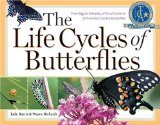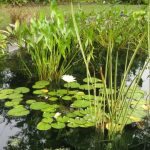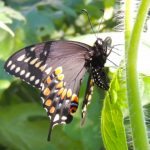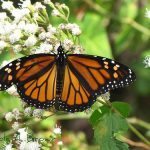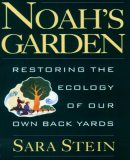I was honored to write a guest post last week for the Little Humbugs Gardening with Chloe series about attracting more butterflies to your garden. In that article I discuss the importance of knowing which host plants are necessary to support the caterpillars of the butterflies you wish to attract.
Butterflies go through four distinctive stages throughout their lives: egg, larva (caterpillar), pupa (chrysalis), and adult butterfly.
During the egg stage the butterfly will develop into a caterpillar, which hatches and must immediately begin feeding on its host plant. The adult female is smart enough to lay her eggs on or near just the right plant so that baby caterpillars will have everything that they need when they hatch from the egg.
If you want to have a specific butterfly in your habitat garden, you must provide the host plant that caterpillar needs. The tiny caterpillar will emerge from the egg and start feeding. It will eat until it outgrows its skin, and then shed that skin and eat some more. This continues until the caterpillar reaches full size when it will find a safe place to go into the pupa stage.
The pupa stage is one of the miracles of nature. The caterpillar liquefies and completely remakes itself into a butterfly. When the process of transformation is complete, the adult butterfly will emerge from the chrysalis and spread its wings in the sun to dry.
It then flies around in search of a mate and feeding on nectar plants, then the cycle will start all over again.
In addition to providing host plants for caterpillars and nectar for adults, you also need to provide shelter for the butterfly to survive the winter. Some butterflies overwinter as eggs, some as larva, some as pupa, and some as adult butterflies.
Shelter can include leaf litter (remember this when you go to rake up your leaves in the fall), tree crevices, rock piles, and wood piles.
This may seem like an awful lot to learn, but fortunately there are many resources to help you on your way to creating a beautiful habitat garden for butterflies.
The Life Cycles of Butterflies, by Judy Burris and Wayne Richards is a wonderful resource. This visual guide follows 23 of the most common butterflies from egg to maturity.
You’ll discover the correct host plants, life history information, identification photographs, and all the information you need to create your butterfly garden. You’ll see whether the butterfly overwinters as an egg, larva, pupa, or adult.
The book is filled with stunning photographs of each stage of the butterfly’s life, range maps, and a wealth of natural history information.
This is a book that just never seems to stay on the shelf, because I keep pulling it down to refer to over and over again.
Now is the time to start planning your butterfly habitat garden. Which butterflies are in your garden? Do you have a favorite winged visitor in your Ecosystem Garden?
More From Ecosystem Gardening:
Submit your review | |

